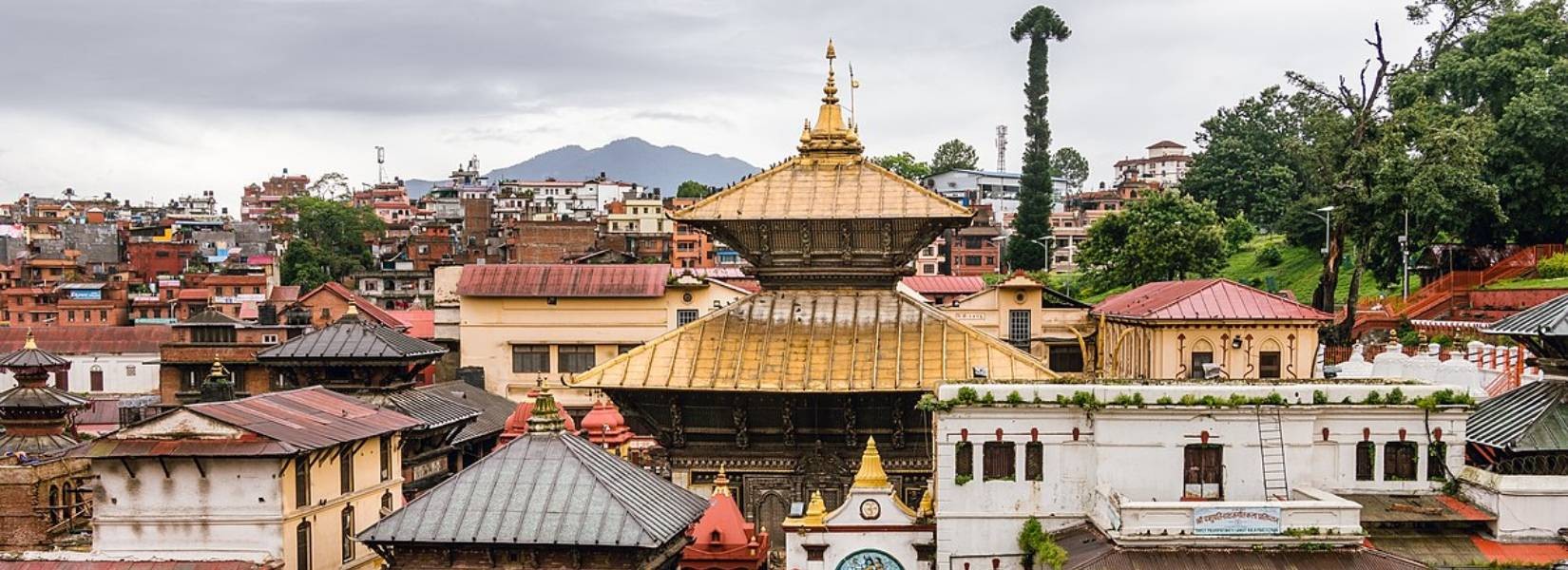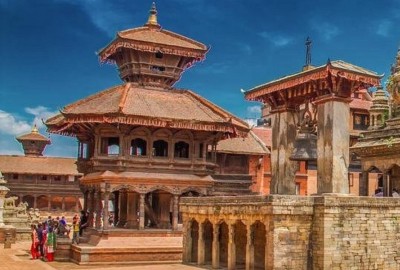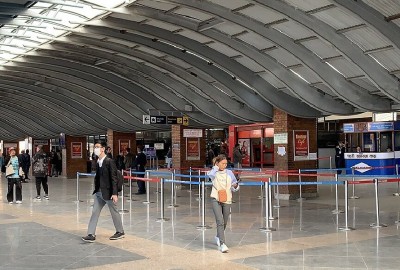Pashupatinath is regarded as one of the most important Hindu religious sites in Asia, worshipping Lord Shiva. The temples are believed to have been made in the 5th century and later renovated by the Malla kings. The site itself has supposedly existed since the beginning of the millennium after the discovery of a Shiva lingam there.
Table of Contents
Plan your trip to Nepal
Customize your trip with help from a local travel specialist.
Known as the temple with the largest area to it in Nepal, Pashupatinath has the holy river Bagmati on both sides of it. The main temple is pagoda styled and has a gilded roof whose four sides are covered in silver with exquisite wood carvings. The area surrounding the main temple is filled with several other Hindu and Buddhist deities.
Alongside the river on a raised platform lay the stone platforms where the cremation of Hindus take place. However, the gate to the main temple only allows Hindus to walk through it. This inner temple area consists of a Shiva lingam along with a statue of Nandi the bull, the divine vehicle of Shiva, which sits facing the temple.
There are hundreds of Shiva linga scattered all around the compound. Furthermore, hundreds of thousands of devotees are attracted by the Maha Shivaratri festival every year from Nepal and India. The temple Guheshwori devoted to Lord Shiva's consort Sati Devi sits on the East side of the compound before Pashupati is reached by the river Bagmati.
Pashupati is approximately 3 km northwest of Kathmandu and sits on the bank of the river Bagmati. Iconic temples and areas which can be found within Pashupati are Gaurighat, Deupatan, Pingalasthan, Jaya Bageshori, Kutumbahal, and Sleshmantak forest. There are 12 phallic shrines, 15 shrines dedicated to Lord Shiva and around 492 temples that can be explored in Pashupatinath.
It is listed in the UNESCO world heritage site as one of the eight heritage sites in Kathmandu valley. The last rituals after a Hindu’s death is also performed here and it is known to be a major cremation site.
Pashupatinath Temple Timing
Unlike other cultures sites, Pashupatinath is always filled to the brim with energy from people participating in rituals all day. The daily rituals at Pashupati have been listed below:
- 4:00 am: Visitors are allowed in from the West gate.
- 8:30 am: The idols of the Lord are cleaned and bathed. Clothes and jewelry are changed for the day after the Pujaris arrive.
- 9:30 am: The Lord is offered breakfast(Baal Bhog).
- 10:00 am: People who want to do Puja are allowed to do so. People can ask the Pujari to carry out a special Puja which is called the Farmayishi Puja. The Puja is done until 1:45 pm.
- 1:50 pm: In the main temple of Pashupati, lunch is offered to the Lord.
- 2:00 pm: There is an ending of the morning prayer.
- 5:15 pm: In the main Pashupati temple, the evening Aarati is started.
- 6:00 pm onward: The Aarati done during this time has gained the most popularity. This place is often overcrowded and lots of people attend on Saturdays, Mondays and special occasions. This Aarati is done on the bank sides of Bagmati and known as the Bagmati Ganga Aarati. Ganga Aarati along with Shiva's Tandava Bhajan is done during the evening Aarati.
- 7:00 pm: The doors of Pashupati is closed.
History of Pashupatinath
While there are many myths about how this temple came into being, the one most believed is the one to do with Lord Shiva. It is believed that Lord Shiva and Parvati while on a journey rested on the banks of Bagmati. They were absolutely mesmerized by the beauty of Kathmandu valley and its forests. The two thought it'd be a good idea to change into a deer and then they roamed around admiring the forest.
There have been several places identified as the one they traveled through. While Lord Shiva was enjoying his time as a deer, the other Gods were searching for him. The Gods finally found him in the forests of Kathmandu and they requested that he go back to his pavilion. Lord Shiva was enjoying his stay so much so that he refused to go back and got into a fight with the Gods. During the fight, he lost one of his antlers.
Lord Shiva finally agreed to go back after a lot of pleas but since he had spent so long as a deer he announced that he was now the Lord of all animals and would be known as Pashupatinath. The lingam appeared from the place where the antlers had fallen and it is believed that whoever comes before the lingam will not be reincarnated as an animal. The lingam disappeared under the ground after a few years and was forgotten about.
After tens of thousands of years, it was noticed that a wish-fulfilling cow, Kamadhenu had taken shelter on the Chandravan mountain inside a cave. Kamadhenu was pouring milk in the very same place where the lingam had disappeared every day.
After people questioned Kamadhenu doing this they began to wonder why, so they dug the area and found the beautiful lingam. It is said that all the sins of the people who dug the lingam out were gone and the people who dug out the lingam disappeared. Pashupatinath was built by devotees when they built a monument around the lingam. It is believed that the wishes of people who visit the temple is fulfilled and that it brings them closer to god.
Places to see at Pashupatinath
Pashupatinath Temple
Constructed in 1696, this pagoda-style temple has stood tall despite the earthquakes. Hindus are the only ones who are allowed to enter inside this temple but you can catch several glimpses of the dazzling temple from some points of the perimeter wall. Nepal's most holy cremation site is near the riverside steps.
On the West side of the compound from the main gate, the golden behind Shiva's bull, Nandi can be seen. A four-headed, black image of Pashupati is hidden inside the shrine. On the East side of the Bagmati from the terraces, you can view the gilded rooftop. The road leading south from the temple's side entrance houses Panch Deval which used to be a temple complex but now acts as a welfare center for the elderly Nepalis.
Western Cremation Ghats
While the Bagmati river is extremely polluted now, it is still a very sacred river. For open-air cremation, the cremation ghats along Bagmati are quite famous and important. After the earthquake of 2015, there was an endless burning of fire here as families dealt with the loss and said their goodbyes.
After the royal massacre of 2001, the 10 members of the Nepali royal family were cremated in front of Pashupatinath. Only royal family members are allowed to be cremated in front of Pashupatinath. The rest of us i.e. the ordinary Nepalese people are cremated on the south side of the temple. With shrouds wrapped along with the bodies, they are laid along the riverbank from where they're cremated on a wooden pyre. This place is a powerful place to contemplate life and death and how mortality is so fleeting. This is a private place for families of the deceased to grieve, so tourists intruding in on their private moments with cameras are not appreciated here.
Shiva Shrines
There are dozens of small Shiva shrines in the garden laden with stone terraces which you get to two footbridges across Bagmati and in front of Pashupatinath temple. Wandering sadhus often stay in these one-room temples which each contain a Shiva lingam. Although made from different styles, the shrines do have common things like Shiva's sinister incarnation, Bhairab, on the South wall; bull head water spouts on the Northside, and on the Westside lies Nandi statues.
Entrance Fees
- SAARC Countries: Rs.1000
- Foreign Countrites: Rs.1000








